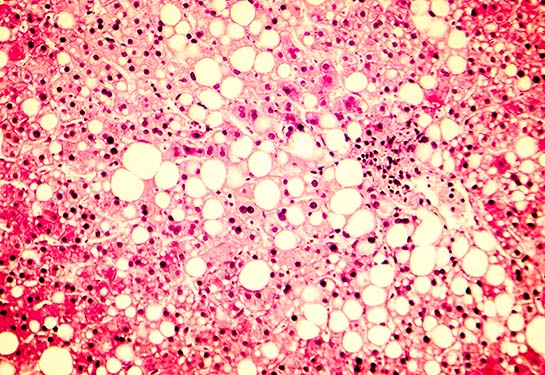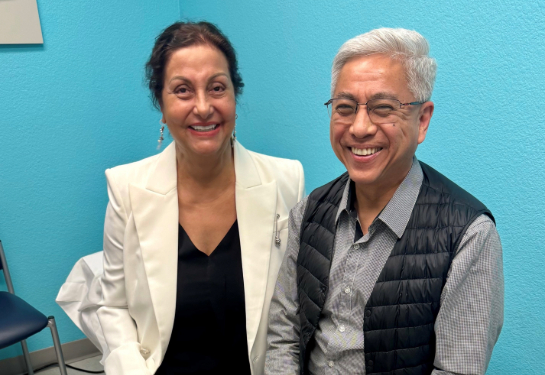New study aims to identify ethnicity-specific markers for non-alcoholic fatty liver disease
Non-alcoholic fatty liver disease (NAFLD) is the most common chronic liver disease, affecting one in four adults worldwide. However, the disease burden is not equally distributed among races or ethnicities.
To better understand why NAFLD affects certain races or ethnicities disproportionately, researchers at UC Davis Health performed a first-of-its-kind study. They examined ethnicity-related changes in bioactive lipids polyunsaturated fatty acids (PUFAs), the by-product oxylipin (OXL) and endocannabinoid (eCB). These are key inflammatory lipid mediators in people with obesity, non-alcoholic fatty liver (NAFL) and the more advanced manifestation which is non-alcoholic steatohepatitis (NASH).
“In the United States, the risk and severity of NAFLD vary among ethnic and racial groups,” said Valentina Medici, vice chair for research in Internal Medicine and senior author of the study. “Hispanics are more at risk of severe inflammation and advanced stage of fibrosis compared to other ethnicities.”
In patients with NAFLD, PUFAs and inflammatory lipid mediators including OXL and eCB are altered and thought to contribute to its progression to NASH. However, the existence of ethnicity-related differences is not clear and not previously explored. This ‘proof-of-concept’ study examined ethnicity-related changes in PUFAs and their inflammatory lipid mediators to determine if there are ethnicity-specific markers for NAFLD.
The researchers employed targeted plasma lipidomic profiling to analyze and identify classes of lipids and their interactions. They focused on plasma PUFAs, non-esterified OXLs and eCBs in ten white Hispanic and eight Caucasian patients with medically complicated obesity and biopsy-confirmed NAFL. They compared them with 14 Hispanic and eight Caucasian healthy control subjects. The present study resulted from an in-depth analysis of previously studied Hispanic and Caucasian patients which were analyzed at UC Davis through both plasma and liver untargeted metabolomic approach.
Results of the preliminary data suggested:
NAFL and NASH were characterized by ethnicity-related differences in plasma PUFA profiles, independent of histological severity
Researchers examined differences in plasma fatty acids and lipid mediators between obese patients with and without NASH. Compared to corresponding healthy subjects without NASH, a different subset of lipids was found in Hispanic and Caucasian patients with NASH. The analysis was conducted and confirmed when matching subsect of subjects by liver histology severity to make sure the observed differences were not due to liver disease severity.
Compared to subjects without NAFLD, Hispanic patients with NAFLD showed lower plasma levels for long chain PUFAs. Instead, in Caucasian patients with NAFLD, there was a trend of higher plasma longer chain PUFAs and downstream lipid mediators. Also, in both ethnicities, NAFL was characterized by higher levels of many eCBs derived from PUFA.
The data also highlighted ethnicity-related differences in OXLs and eCBs associated with NASH progression. Given that NASH groups in both ethnicities had comparable liver histology severity scores, this suggests the ethnicity-related differences observed with NASH are not likely driven by histological severity.
Ethnicity-related differences in plasma OXLs profiles characterized NASH, independent of histological scores
A supervised partial least square-discriminant analysis was performed including all profiled lipids to examine if a plasma OXL profile can discriminate between ethnicities with NASH. The model demonstrated separation between Hispanic and Caucasian patients with 22 (49%) contributing lipids reaching the threshold for statistical significance for variable selection. This indicated differences in OXLs profile for Hispanic and Caucasian patients with NASH.
Of note, an overlap between ethnicities was observed in subjects with advanced fibrosis, indicating that Hispanic and Caucasian patients with severe NASH and advanced fibrosis shared similar plasma OXLs profile. Also, it suggested that advanced fibrosis may be reducing the effect of the multivariate model.
In subjects with NASH and mild to moderate fibrosis, OXL profiles showed opposite direction of change between ethnicities in some arachidonic acid-derived mediators being lower in Hispanic patients compared to Caucasian patients. Many OXLs derived via lipoxygenases pathway and/or auto-oxidative routes were lower in Hispanic patients with NASH. Some cytochrome P450s-derived OXLs were lower in Hispanic patients with NASH.
These findings further confirmed lower arachidonic acid-derived OXLs in Hispanic patients with NASH, which are also characterized by lower lipoxygenases and higher sEH-derived lipid mediators compared to Caucasian patients. These findings indicate that ethnicity-related differences regarding plasma OXL profiles in patients with NASH.
Plasma PUFA profile is altered in healthy Hispanic subjects
Ethnicity-specific differences in the complete lipid profile within lean healthy control patients were examined. Among the differences observed by researchers, Hispanic patients had higher linoleic acid, α-linolenic acid, hydroperoxide, and trihydroxyoctadecaenoic acid levels, and lower arachidonic acid-derived prostaglandin, prostaglandin levels. These results indicated alterations in plasma PUFAs and lipid mediator profiles in Hispanic subjects independent of obesity.
Researchers also conducted a secondary analysis, including prospectively collected subjects to compare and validate OXL profile between ethnicities in NASH. This analysis compared ethnicities within 12 Hispanic and 17 Caucasian patients with NASH. Data confirmed that Hispanic patients with NASH were characterized by lower levels of arachidonic acid derived OXLs, lower lipoxygenases with an upregulated sEH pathway(s) compared to Caucasian patients with NASH. These lipidomic differences may be relevant to the ethnicity-related disparity reported in NAFLD rate and severity.
“Although preliminary, our findings corroborate the epidemiological evidence indicating ethnicity as one variable affecting the association between PUFAs and risk of advanced stage NASH,” explained Medici. “Therefore, the research suggests ethnicity-specific lipidomic signatures may characterize and explain the progression to NASH. We hope to soon be able to begin additional validation studies.”
The team of researchers included faculty and scientists from UC Davis Health's Division of Gastroenterology and Hepatology, Department of Surgery, Department of Pathology, Department of Molecular Biosciences and the USDA’s Human Nutrition Research Center.




